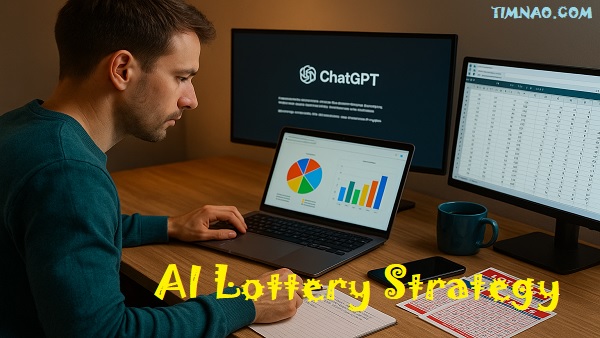AI Lottery Strategy: 7 Surprising Ways Beginners Can Use ChatGPT to Boost Their Odds
If you’ve ever felt like playing the lottery is just a blind shot in the dark, you’re not alone. Most players rely on gut feelings, lucky numbers, or quick picks—without realizing there are smarter ways to engage with this age-old game of chance. While it’s true that no tool or system can guarantee a win, what if you could shift your approach from purely emotional to intelligent and data-informed?
That’s where AI-powered tools like ChatGPT come in.
This article is designed specifically for beginners who want to learn how to use artificial intelligence—without needing a background in coding or math—to improve their lottery play. You’ll discover how to:
-
Understand the types of lottery games and how odds actually work
-
Use ChatGPT to analyze historical data and generate number patterns
-
Set up simple spreadsheets to test your strategies
-
Simulate lottery draws and refine your combinations over time
Whether you’re aiming for small wins or just want to stop wasting your money on completely random guesses, this guide will show you how to take control of your lottery experience using beginner-friendly AI tools.
Let’s break down the steps to play smarter, not harder.
🧭 Table of Contents
- 🎯 Why Most People Fail at an AI Lottery Strategy
- 🧠 ChatGPT Basics: The Brain Behind Your AI Lottery Strategy
- 🔧 Tools You Need to Build Your AI Lottery Strategy from Scratch
- 🧩 Choosing the Right Lottery Game for an Effective AI Lottery Strategy
- 📊 Beginner-Friendly AI Lottery Strategy Techniques Using ChatGPT
- 🔄 Testing, Tracking, and Improving Your AI Lottery Strategy
- ✅ Final Thoughts: Make AI Lottery Strategy Work Without Losing Your Mind
🎯 Why Most People Fail at an AI Lottery Strategy
Let’s be real—most people play the lottery like it’s a ritual. They pick birthday numbers, use quick picks, or go with a “lucky number” their uncle swore by in the ’80s. While there’s nothing wrong with a little fun or nostalgia, the truth is, the lottery is a numbers game. And numbers don’t care about feelings.
So what if you could stop guessing and start analyzing?
That’s where AI, and more specifically ChatGPT, changes the game. Not by predicting the future—because no one (and no AI) can do that—but by helping you become a smarter player.
This article is your beginner’s guide to using AI tools to boost your understanding of the lottery. And while it won’t guarantee a win, it’ll definitely help you stop playing blind.
🧠 ChatGPT Basics: The Brain Behind Your AI Lottery Strategy
ChatGPT is an advanced AI model that understands and generates human-like text. It can explain complex topics, simulate scenarios, analyze historical data, and help you structure your thoughts better. While it’s widely known for answering questions or writing essays, it also has powerful applications in areas like lottery analysis.
For lottery beginners, ChatGPT is like a personal assistant that doesn’t sleep. It can help you:
- Identify trends in past lottery results
- Explain confusing terms like “odds,” “permutations,” or “number wheeling”
- Suggest ways to structure a spreadsheet for your lottery tracking
- Simulate mock lottery draws to test strategies
- Generate prompts or mini-programs that analyze number clusters
Think of ChatGPT as your friendly neighborhood data nerd with unlimited patience.
But Wait—Can ChatGPT Pick Winning Numbers?
No, and anyone who says otherwise is either misinformed or trying to sell you a scam. Lotteries are designed to be random. But randomness doesn’t mean you can’t use historical data and smart tools to increase your chances of smaller wins or minimize wasted plays.
🔧 Tools You Need to Build Your AI Lottery Strategy from Scratch
Before you start running simulations and analyzing number patterns, let’s look at what you actually need to get started. You don’t need a PhD, but you do need:
✅ 1. A ChatGPT Account
Visit OpenAI’s ChatGPT and sign up. Start with the free plan, or upgrade to GPT-4 if you want better performance.
✅ 2. A Spreadsheet Tool
Use Google Sheets (free) or Microsoft Excel (paid). You’ll use these to organize your data, automate calculations, and track results.
✅ 3. Historical Lottery Data
You can get this from most official lottery websites, like:
- Powerball.com
- MegaMillions.com
- State lottery websites
Download the data as a CSV or paste it directly into your spreadsheet.
✅ 4. A Few Prompt Ideas to Start With
Here are example prompts you can give to ChatGPT:
- “Can you find the most common number pairs in these results?”
- “Highlight all numbers that have repeated more than 3 times in the last 20 draws.”
- “Explain the concept of lottery wheeling and how it affects odds.”
You’ll learn more as you go. The point is to start experimenting.
🧩 Choosing the Right Lottery Game for an Effective AI Lottery Strategy
Not all lottery games are created equal. Before you start throwing AI at your number picks, you should understand the two main types of games you’ll likely encounter:
🎲 Pick-3 Games (Better Odds, Lower Payouts)
- Choose 3 digits (0–9)
- Total combinations: 1,000
- Odds of winning: about 1 in 1,000
- Good for: frequent small plays, lower budgets
🎰 Pick-6 Games (Lower Odds, Bigger Payouts)
- Choose 6 numbers (often 1–49 or 1–69)
- Combinations: over 13 million (or 292 million for Powerball!)
- Odds of winning: varies drastically
- Good for: dream chasers, high jackpots
🎯 Smart Tip for Beginners: Start with Pick-3 or Pick-4 games to understand patterns and test strategies. These games are simpler and easier to model.
📊 Beginner-Friendly AI Lottery Strategy Techniques Using ChatGPT
Once you understand the basics of the lottery and the tools you need, it’s time to get tactical. This section breaks down easy-to-follow, beginner-approved strategies that use ChatGPT and basic data tools to help you make smarter decisions and avoid common pitfalls.
Remember, we’re not here to “crack” the lottery. We’re here to play smarter, track better, and understand probability on a deeper level.
🧮 Strategy 1: Identify “Hot” and “Cold” Numbers with AI
One of the most popular lottery strategies is identifying hot numbers (those drawn frequently) and cold numbers (those rarely drawn).
How ChatGPT Helps:
You can feed a dataset into ChatGPT and ask:
“Which numbers in this dataset have appeared more than five times in the past 30 draws?”
ChatGPT will return a list of frequently drawn numbers, helping you see possible trends. While the lottery is still random, these trends can help you decide whether to follow the pattern (pick hot numbers) or go against it (choose cold numbers that might be “due”).
✅ Bonus: Paste your draw history into a spreadsheet. Then ask ChatGPT:
“What’s the formula to count how often each number appears in column A of my spreadsheet?”
It’ll return something like:
=COUNTIF(A:A, number)
Use this to tally how often each number has come up.
🔗 Strategy 2: Use Number Grouping and Ranges
Instead of just choosing your favorite digits, try grouping your picks based on number ranges. In a Pick-6 lottery with numbers 1 to 49, you can divide the range into:
- 1–10
- 11–20
- 21–30
- 31–40
- 41–49
Ask ChatGPT:
“Can you help me create a balance between number groups in this range for Pick-6 combinations?”
This encourages even coverage across number sets. Many historical draws show that a well-distributed number set (e.g., two numbers from 1–20, two from 21–40, etc.) performs better than clustering all six numbers within a tight range.
🧠 Why it works: Balanced number sets statistically have a higher chance of matching partial results, which can qualify you for lower-tier prizes.
🔁 Strategy 3: Repeat Analysis for Draw Patterns
Some lottery draws show patterns like:
- Consecutive Numbers: 7–8–9
- Same Ending Digits: 14–24–34
- Odd vs. Even: 4 odds and 2 evens, or vice versa
Ask ChatGPT to analyze these trends:
“Based on these past 100 draws, how often do consecutive number pairs appear?”
You’ll start to see patterns that, while not predictive, can guide your ticket design to mimic past successful combinations.
🧠 Smart Tip: Use ChatGPT to simulate these formats across different games to test your assumptions.
🛠 Strategy 4: Build a “Wheeling” System Using ChatGPT
Lottery wheeling is a strategy that helps you play more combinations using a subset of your favorite numbers. It increases your chances of winning lower-tier prizes.
Example:
You choose 8 favorite numbers but can only play 6 per ticket. Instead of randomly combining them, a wheel system will generate all possible combinations from your pool in a structured way.
Ask ChatGPT:
“Can you create a lottery wheeling system using these 8 numbers for Pick-6 combinations?”
It will return several combinations like:
- 2, 5, 8, 12, 17, 22
- 5, 8, 12, 17, 22, 33
- …and so on
🧠 Why it matters: This strategy doesn’t increase your jackpot odds directly, but it greatly boosts your chances of matching 3, 4, or 5 numbers in any given draw.
You can also ask:
“How can I integrate these wheel combinations into my Google Sheets for tracking?”
ChatGPT will guide you with formulas and formatting suggestions.
📏 Strategy 5: Use Odd/Even and High/Low Ratios
Smart players consider number traits like odd/even and high/low balances. Most winning tickets aren’t all odd or all even. They’re usually a mix, like:
- 3 odd / 3 even
- 2 high / 4 low
You can instruct ChatGPT:
“Analyze the last 50 draws and find the most common odd/even split.”
Then apply that ratio to your ticket designs for future plays.
💡 Try This Prompt:
“Split the number range 1–49 into high/low and suggest combinations that balance both sides based on previous draws.”
🔄 Testing, Tracking, and Improving Your AI Lottery Strategy
Strategy without testing is guesswork. The next phase in becoming a smarter lottery player is building a testing system using spreadsheets and AI.
🔬 Step 1: Build a Spreadsheet System
If you want to test strategies efficiently, create a spreadsheet that includes:
| Ticket # | Numbers Played | Match Count | Winnings |
|---|---|---|---|
| 001 | 4, 7, 12, 22, 33, 44 | 2 | $0 |
| 002 | 8, 15, 18, 21, 25, 37 | 3 | $5 |
Ask ChatGPT:
“How do I calculate how many numbers in column B match a winning set in column D?”
It can return a formula like:
=SUMPRODUCT(COUNTIF(SPLIT(B2, ", "), D2:D7))
Replace with actual cell references. This setup lets you simulate hundreds of draws and test combinations fast.
🧪 Step 2: Run AI-Powered Simulations
Simulations help you see if your strategy has legs or if it’s pure luck in disguise.
Try asking:
“Simulate 100 lottery draws using random Pick-6 combinations and summarize how often 3 or more numbers matched.”
You can refine the prompt:
“Simulate 100 draws where each ticket uses a wheeled set of 8 numbers, and track the match frequency across tiers.”
This is powerful for:
- Testing your number selection logic
- Measuring expected returns over time
- Validating or discarding flawed strategies
💡 Pro Tip: Save multiple simulations. Compare strategies across different ticket sets or draw periods.
📊 Step 3: Chart and Visualize Trends
Once your data grows, visual aids help make sense of it.
Ask ChatGPT:
“How can I create a bar chart in Google Sheets to show how often each number appeared in my dataset?”
It will provide step-by-step guidance to generate charts like:
- Frequency of numbers
- Win tiers over time
- Performance of odd vs. even setups
These visuals aren’t just pretty—they help you identify patterns at a glance.
✅ Final Thoughts: Make AI Lottery Strategy Work Without Losing Your Mind
You’ve now explored how ChatGPT can elevate your lottery play from random guesses to an organized, data-driven strategy. But before you rush off to start wheeling numbers and running simulations, let’s talk about the mindset behind all of this.
🎯 The Goal Isn’t to “Hack” the Lottery—It’s to Play Intelligently
The truth? You can’t eliminate luck. Lotteries are designed to be random. However, intelligent players understand how to maximize small wins, reduce wasted plays, and engage with the lottery on their own terms. That’s where the strategies you’ve learned—from prompt engineering to statistical modeling—really shine.
With ChatGPT, you’ve gained more than just insights. You’ve gained:
- A consistent way to test ideas
- A personal analyst that works 24/7
- A creative partner that helps brainstorm and refine your approach
This is where many players fall short. They want a shortcut to jackpot riches. You now know that shortcuts don’t exist—but structured, smart planning? That absolutely can improve your results over time.
🔁 Rethink the Role of ChatGPT in Your Long-Term Strategy
Let’s reframe ChatGPT not as a lottery “hack,” but as part of a dynamic lottery system. It’s not something you consult once—it’s a tool you work with continuously. Here are five long-term ways to make it part of your system:
🔄 1. Weekly Trend Reviews
Set up a process where you review your most recent plays and compare results.
Example prompt:
“Based on my past 10 ticket combinations and the last 10 draws, what number patterns should I reconsider?”
📆 2. Ticket Journal Logging
Start a “Lottery Journal” in Google Sheets or Notion. Every time you play, log:
- Your chosen numbers
- Why you picked them (wheel, pattern, intuition)
- Result (win/loss)
- AI suggestions used
Over time, you’ll see which strategies perform best.
🧠 3. Monthly Strategy Audits
Once a month, do a full strategy review. Ask:
“Here are my last 50 plays. Help me analyze which prompts led to the most matches, even if they weren’t winning tickets.”
This shows which techniques are consistently aligning with draw patterns—even when you’re not hitting prize tiers.
🧮 4. Confidence-Based Budgeting
Use ChatGPT to help you define a fixed play budget. Example:
“Help me create a lottery budget plan that limits my weekly spend to $20 and allocates tickets across high, medium, and low risk games.”
Now you’re not only playing smarter—you’re playing responsibly.
🤝 5. Combine ChatGPT with Community Insights
There are entire forums, subreddits, and Discord groups focused on AI and lottery systems. You can prompt ChatGPT like this:
“Summarize recent Reddit posts about AI-based lottery strategies. What trends are people discussing in 2025?”
Stay connected to a broader community so you’re always improving, not just relying on your own ideas.
🎭 Busting the Top 5 Myths About “AI and the Lottery”
Even with tools like ChatGPT, some beliefs can derail your thinking. Let’s dismantle them.
❌ Myth 1: AI Can Predict Winning Numbers
Wrong. ChatGPT cannot and will not predict the future. What it can do is analyze, organize, and simulate. You’re still making the final choices, and randomness rules the outcome.
❌ Myth 2: More Tickets = Better Strategy
More tickets mean more entries—but not necessarily better strategy. A badly constructed wheel or a clustered number set can make multiple tickets useless. Use ChatGPT to design smart combinations—not just more of them.
❌ Myth 3: Lottery Data is Too Complex
With tools like ChatGPT and spreadsheet templates, even a beginner can build and understand a basic dataset. Ask:
“Explain how to build a frequency heatmap in Google Sheets using my draw history.”
You’ll be shocked how accessible this becomes.
❌ Myth 4: Only Math Geniuses Can Use These Systems
Thanks to natural language prompts, you can now ask ChatGPT:
“Explain number dispersion in lottery draws like I’m 12 years old.”
It will give you a digestible, actionable response. Intelligence isn’t about complexity—it’s about asking the right questions.
❌ Myth 5: Lottery Strategy is Only for the Obsessed
Even casual players can benefit from these tools. A small shift in how you pick numbers, track results, or analyze outcomes can save money and increase small-tier winnings.
🧱 Building a Personal Lottery Strategy with ChatGPT
Want to go next-level? Here’s a 5-layer framework to build your own AI-powered lottery strategy from scratch.
🔹 Layer 1: Define Your Game Goals
- Are you playing for fun, to test AI tools, or aiming for regular wins?
- Decide how much time and budget you’re willing to invest.
ChatGPT prompt:
“Help me design a weekly lottery strategy for $10 that focuses on games with the best odds for small wins.”
🔹 Layer 2: Research the Game Format
Don’t treat all games the same. Ask:
“Compare Pick-3 and Pick-6 lottery formats in terms of odds, strategy, and ideal play methods.”
Let ChatGPT help you select games based on your goals.
🔹 Layer 3: Generate Smart Combinations
Once you understand the game, prompt:
“Generate 5 unique lottery combinations using wheeled subsets of these 9 favorite numbers: [list].”
Then validate:
“Check those combinations for even coverage across high/low and odd/even splits.”
🔹 Layer 4: Track and Simulate
Feed your played numbers and results into a spreadsheet. Ask:
“Can you create a dashboard that tracks win ratios and number appearance over time?”
Then run test draws:
“Simulate 30 draws using these numbers and return the frequency of matches by tier (3-match, 4-match, etc.)”
🔹 Layer 5: Review and Refine
Every 2–4 weeks, review your logs. Use prompts like:
“Given these 10 most recent results, which number groups underperformed?”
Adjust based on results—not emotion.
💡 Smart Tips to Stay Grounded
- Always remember: even the best strategy cannot guarantee a win
- Don’t chase losses: increasing your plays after a losing streak is a quick path to burnout
- Stick to a plan: spontaneous number picks undermine your system
- Keep it fun: this should be an engaging hobby—not a financial strategy
🌅 Conclusion: Play Smarter, Not Harder
You’re now equipped with everything you need to transform the way you approach the lottery:
✅ You understand the core types of lottery games
✅ You know how to use ChatGPT for analysis and strategy
✅ You’ve learned how to track your results like a pro
✅ You can simulate, refine, and evolve your plays over time
✅ Most importantly—you know how to play responsibly
AI isn’t magic—but it’s a force multiplier. And when paired with structured thinking, tools like ChatGPT can help you avoid rookie mistakes, refine your strategies, and inject a new level of excitement into your lottery experience.
So the next time you go to pick numbers, don’t just guess. Chat with your AI assistant first—and give yourself the best shot possible.
⚠️ Disclaimer
The information provided in this article is for educational and informational purposes only. It is not intended as financial advice, gambling advice, or a guarantee of lottery success. While strategies involving AI tools such as ChatGPT can help you analyze data and structure your lottery plays more intelligently, lotteries remain games of chance with inherently unpredictable outcomes.
Neither the author nor this website makes any promises of winning or financial gain from the use of these strategies. Please gamble responsibly and only play the lottery within your means. If you struggle with gambling or addictive behaviors, seek help through resources such as BeGambleAware.org or your local support services.
The tools, platforms, and services mentioned are not affiliated with or endorsed by any national or state lottery authority. All trademarks are property of their respective owners. This content is not sponsored by or affiliated with OpenAI.









